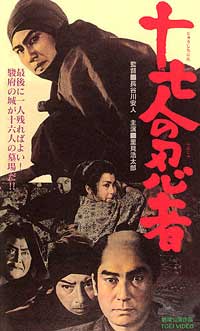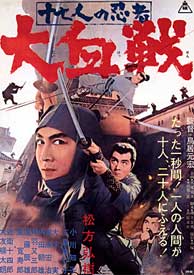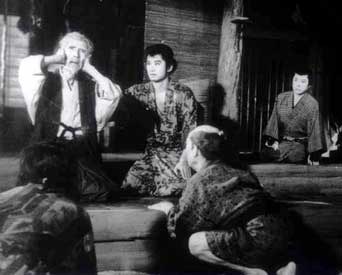Shadow of Hell (Jigoku no kageboshi, Toei, 1962) is a charming family film, pretty to look at, not particularly action-oriented with its few bloodless duels. It is of the "samurai detective" genre, telling a rather involved but eventually comprehensible who-done-it, decorated with such interesting asides as a ceremonial tea ritual.
Kokichi Takata plays Shin, the street musician who turns out to be a samurai government agent. He's adorable & sweet, & his acting style is very similar to that of Hashizo Okawa, though Takata does not have Okawa's extreme prettiness because he's not as young. Takata starred in chambara films of the 1930s & returned in the post-occupation era to make a few more films. His charm can cause us to lament that with a few exceptions most of his pre-war films have been lost or destroyed.
The most menacing character in Shadow of Hell is the ronin with an iron leg (Isao Yamagata) & even he turns out to be one of the good guys. Essentially this is a film designed to amuse but not shock & there is nothing in the characters, action, or story to hint of the nihilistic bloodletting of adult samurai films.
Fascinating characters spice the drama, not only the iron-legged ronin Nikaido, but also Kinu the woman detective working under an Edo magistrate. Her sensitive, somewhat comical, middle-aged aide practically worships his young lady-boss. There's an old retired ninja we get to see in his homelife, & a likeable shogun. Importantly, there's Princess Yuki, whose mother was a kunoichi (woman ninja) & who was secretly raised to be a master of fighting arts.
The duelling Princess Yuki is on a mission of vendetta, killing one by one those faithless retainers who had conspired against her father, the Shogun's brother, framing him for treason.
Although the film itself is bloodless, the implications of the plot are rather extreme. While Shin the samisen player & Kinu the lady detective try to solve the growing number of murders, five men end up slain with notes saying "Punished for Lord Suruga" nailed to their foreheads. Eventually even Edo Castle is damaged by explosives & the magistrate, Kinu's employer, is forced to commit seppuku off-stage.
As the plot does a couple of convolutions we find out Princess Yuki is unknowingly a pawn of conspirators hoping to make her the first female shogun, believing they can better manipulate a woman in that office. She turns her considerable skills as a swordswoman & ninjutsu practitioner against the true culprints, helping save Japan from being thrown into confusion by corrupt officials.
There is some nice stuff going on in this tale but typical of the bloodlessness of a film which is only superficially action-oriented, Yuki, dressed as a young samurai, duels the iron-legged ronin for only about five seconds, then there's an intervention that allows her to escape.
When Shin faces the same ronin, seemingly unarmed but for his samisen, he suddenly takes his instrument apart to reveal a short spear in its neck. As these two face off for a duel, there is distracting commotion: another retainer has been murdered -- off stage -- & the promise of an on-screen duel between Shin & Nikaido goes no further.
Near the climax, Shin & Princess Yuki fight one another with empty hand techniques, a fight that looks more like a dance on the raked Zen sand-garden.
In the climax, Yuki & Shin & the iron-legged ronin join forces & lead a purge against the conspirators inside Edo Castle, villains falling before their swords, but we don't actually see any of 'em bleed. When the real villain is unveiled (& it's the sort of who-done-it you can solve yourself by paying attention) he is cornered & allowed to commit seppuku on the spot. Rather than being shown the gruelling belly-slit, we have a close up of his face as he experiences pain, & a speck of blood oozes from his lips.
The story is filmed tastefully & overcomes most of its campier, fantastic elements so that it is quite possible to take it all seriously. It's slow in places, & takes its time stringing a dozen diverse elements together for the viewer. But as in most Japanese films with cross-dressing female characters, it is impossible for the viewer to grasp how & why Princess Yuki's disguise fools anyone let alone everyone.
By the happy ending, as expected of Toei's sweety-pie adventures, Yuki is becoming a "normal" woman no longer using martial arts, her revenge being complete by then, & shuffling off in a nice kimono rather than dashing about in hakama or ninja costume. This expected outcome for women adventurers always annoys me a bit, as by my sentiment it's the equivalent of a samurai character after one adventure happy to be a store clerk forever after.
The lady detective likewise gives up her profession to go off with Shin who she had fallen in love with even before she found out he's an important samurai rather than vagabond street musician. The only element of tragedy remaining is the sadness of the Tokugawa Shogun who now knows conclusively that he had ordered his brother to commit seppuku unjustly.
 When the Shinobi no mono series became a giant hit for Daiei Studios starting in 1962, rival Toei Studies wanted in on the craze for serious, gloomy, & severe ninja stories told from the perspective of depressive ninjas. When the Shinobi no mono series became a giant hit for Daiei Studios starting in 1962, rival Toei Studies wanted in on the craze for serious, gloomy, & severe ninja stories told from the perspective of depressive ninjas.
Yasuto Hasegawa directed The Seventeen Ninja (Jushichinin no ninja, 1963) starring Kotaro Satomi, Jushiro Konoe, Ryutaro Otomo & Yuriko Mishima. The film had many wonderful night scenes with noirish black & white cinematography & strove to recreate "realistic" ninjutsu arts in the manner of Shinobi no mono.
Its sequel was The Seventeen Ninjas: Ammunition & Ambition; aka, The Great Battle (Jushichinin no ninja: daikessen; aka, Daikessen, 1965), directed by Motohiro Torii, the screenwriter for the third Hibotan bakuto episode Red Peony Gambler: The Hanafuda Game (1969).
 The script for both "seventeen ninja" films was Kaneo Ikagami, who also scripted the Tatsuya Nakadai vehicle Bandit vs. Samurai Squad (Kumokiri nizaemon, 1978) directed by Hideo Gosha. The script for both "seventeen ninja" films was Kaneo Ikagami, who also scripted the Tatsuya Nakadai vehicle Bandit vs. Samurai Squad (Kumokiri nizaemon, 1978) directed by Hideo Gosha.
The cast includes Hiroki Matsukata, Ryutaro Otomo, Jushiro Konoe, Tomoe Ogawa, Yuriko Mishima, Minoru Oki, Tatsuo Endo, Kinji Nakamura, Kinoto Harada & Koji Inaba.
Superb black & white night photography with gorgeous contrasts is heightened in its effect by complete soundlessness for scenes of ninja stealth, thanks to scope cinematographer Shigero Akatsuka, an old hand at making yakuza & samurai films look gorgeous even on slim budgets.
Set in 1651, the Koga ninja leader Jinza guards the gun ammunition depository. Iga spies, lead by Hanzo (Ryutaro Otomo), must stop the Kishu revolt by destroying the ammunition. Through the turmoil Shizaburo & Yuka want to break the no-love taboo among ninjas so that they might strive for the forbidden life of happiness.
Jushichinin no ninja was remade by Toei as a telefilm in 1990, starring Shinichi "Sonny" Chiba.
copyright © by Paghat the Ratgirl
|


 The script for both "seventeen ninja" films was Kaneo Ikagami, who also scripted the Tatsuya Nakadai vehicle Bandit vs. Samurai Squad (Kumokiri nizaemon, 1978) directed by Hideo Gosha.
The script for both "seventeen ninja" films was Kaneo Ikagami, who also scripted the Tatsuya Nakadai vehicle Bandit vs. Samurai Squad (Kumokiri nizaemon, 1978) directed by Hideo Gosha.